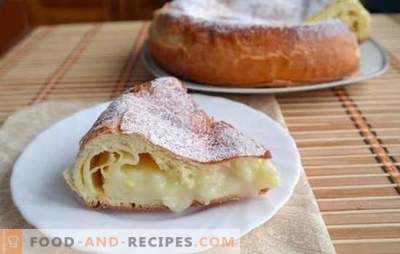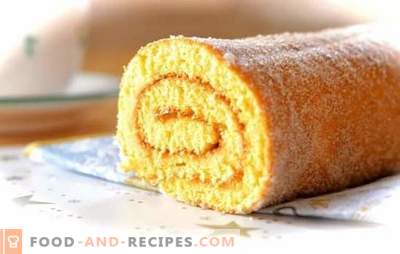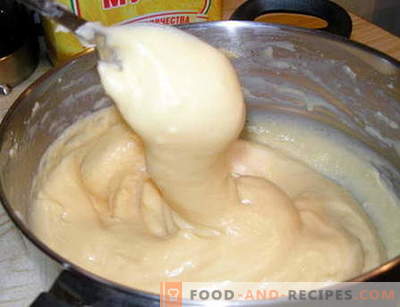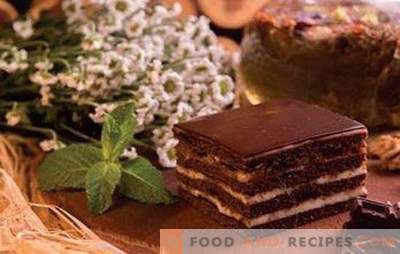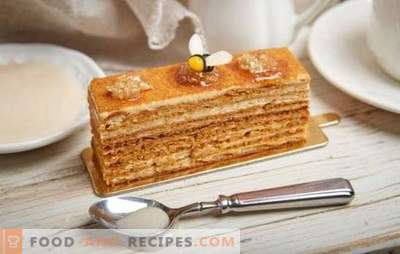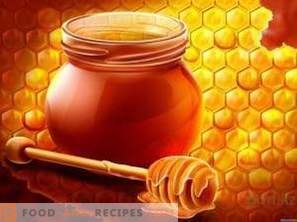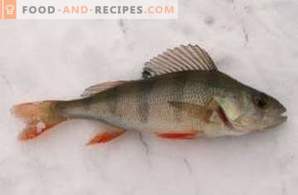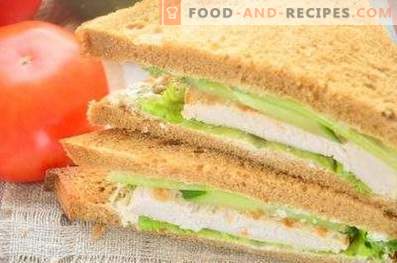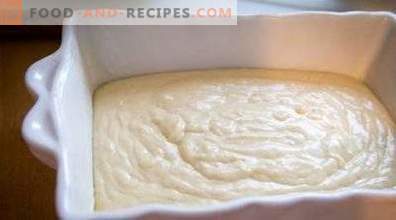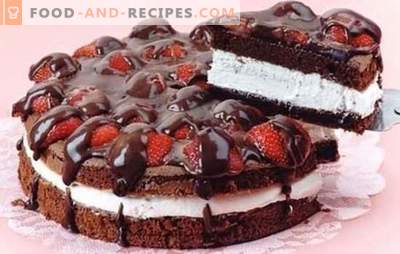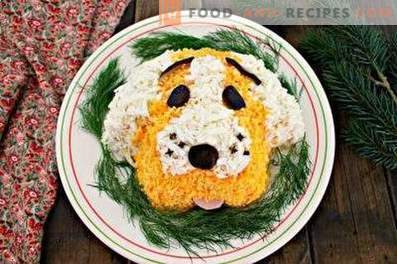
Cakes in the form of tubes or cones, mainly made from custard and layered dough. This is the very classic variety of sweets that evoke pleasant memories from a distant "soviet" childhood. True, such cakes are made now, in an advanced capitalist era. It is a pity that for those who are so scornful of the Soviet period of our history, there is no way to compare that taste with what is now offered to customers, in conditions when the pursuit of profit decides everything.
The only opportunity to taste the real taste of custard tubs is to get the recipes of the Soviet catering, buy fresh home-made products and cook delicious cakes in your own kitchen, not saving on pleasure. At the same time, having familiarized with the basics of the technology of preparing various dough and custard creams, you can experiment, prepare the tubes according to your own unique recipes.
Quiches - the basic technological principles
The main drawback in custard from modern manufacturers of confectionery products is the use of cheap products with a content of vegetable fats and other additives, which should not be in natural oil.
Every professional pastry chef knows that oil should not contain anything other than milk fat. The best option for creams in confectionery products is oil containing 82.5% fat. The unscrupulous manufacturers of confectionery products often do not even mask the essences because of the unpleasant taste and smell of various impurities in the creamy fat, because they are more expensive than natural oil. But even if you try to drown out the taste of the spread with the help of aromatic additives, it still will not work. Natural oil is better and faster whipped, the cream from it retains its pomp and stability, without requiring the use of various thickeners and stabilizers.
In some pastry recipes, spreads and margarines are allowed, but only for dough, because spreads contain more moisture, which, evaporating during the baking process, forms a more porous structure. With margarine or a spread of good quality, you can change the butter in the choux pastry, but in the sand or waffle dough the use of these ingredients makes the dough less crumbly. Pay attention also to the quality of the eggs. Their pomp when whipping depends on the freshness of the product. Moreover, you can not use the stale protein for the preparation of creams based on it in a cold way.
For the manufacture of “Duct” cakes, the highest grade flour is used, with a high percentage of gluten, as it absorbs more water, which contributes to the improvement of the dough during baking, the pomp of semi-finished dough. In addition, the flour in front of the batch must be sifted, even if absolutely sure that it does not contain impurities. Saturation of the product with oxygen also improves the quality of the finished products.
The most difficult component in baking is sugar, from the point of view of its properties, transformation, depending on the methods of its mechanical and heat treatment. The best sugar for confectionery is refined sugar. He is white, purified, has no impurities. In the process of preparing creams, refined sugar is whipped better, and it is also easy to make powder from it. Using powdered sugar when whipping significantly reduces the time spent on cooking and improves the quality of products.
It is not recommended to change the amount of sugar in the recipe, or, in any case, it should be done very carefully: the lack of a product in the product, like its excess, affects the quality of the cream and dough. Ruddy crust, for example, forms sugar. Too sweet dough quickly burns, dries during storage. Beating protein, binding with sugar molecules, acquires additional stability, but if the sugar in the protein cream is more than the norm, then the cream is whipped for a long time, it turns out less fluffy.
In general, to obtain high-quality pastry you need to choose only the freshest and best ingredients. Another tip: in the recipe you like, be sure to pay attention not only to the composition of the ingredients, but also to follow the preparation technology, because the result often depends on how well the whipped proteins or cream are mixed with the rest of the ingredients of the dough or cream.
1. Custard Tubes with Custard
For choux pastry:
Flour 280g
Salt 2 g
Milk 180 ml
Butter, sweet cream 80 g
Eggs 6 pcs.
Cream custard, oil:
Corn Starch 60 g
Milk, whole 300 g
Eggs (D-1) 3 pcs.
Sugar 140g
Vanilla sugar 4 g
82.5% high grade oil 350 g
Cooking Technology:
Pour the milk or water into a saucepan, add salt and butter, bring to a boil. Brew the dough over low heat. Sprinkle flour, whipping the mixture with a whisk until the lumps are removed. Mix the flour in small portions, pouring it into the pan through a strainer. Without stopping stirring, brew the dough for 2-3 minutes. Make sure not to burn.
Remove the pan from the stove, cool to 65-70? C and beat in one egg, stir the dough intensively (do not whip!).
Grease a baking tray and lightly flour. Transfer the dough into a bag with a toothed nozzle (? 0.5 cm). At a distance of 3 cm, roll the strips out of the pastry bag onto a prepared baking sheet, 5 cm long. Bake at 200? C - 20 minutes, then lower the temperature by 20? C and bake 15 minutes. To prevent the semi-finished products from breaking and settling, open the oven after baking and leave them there for 10 minutes.
Custard for the filling:
Beat eggs with sugar. Add starch to milk, mix, brew until a thick jelly forms. Pour it into the egg mass, with intensive stirring. Bring the mass to a boil again in a water bath (so as not to burn). Chill. Add soft butter, vanilla and beat to a creamy consistency.
If there are no special pastry devices (syringes with nozzles), make cuts in the semi-finished products of custard dough from the side and put the cream inside with a spoon.
Decorate the tubes can be sugar or chocolate icing, fudge.
2. Wafer rolls with custard
For waffle dough:
Eggs (D-1) 5 pcs.
Honey 80g
Sour cream 150 g
Flour 140 g
Soda 5 g
Vanilla (extract)
Margarine (high grade) 140 g
Salt 2 g
For custard nut cream:
Whole milk 280 ml
Sugar, refined 250 g
Flour (high grade) 30 g
Oil 400 g Nuts, roasted shredded (to taste) 150 g
Cognac 70 ml
Cooking Technology:
Eggs, honey and sour cream whisk into a lush mass, adding a little sifted flour with salt and soda. Add melted margarine to the dough. It should get the consistency of the dough, as for making pancakes.
Bake waffles with an electric waffle iron. Hot turn into tubes, then into the tubes enter custard with a pastry syringe with a long nozzle.
What to do if there is no miracle waffle iron? Bake waffles in a regular frying pan, just make the dough's texture less often by adding a little water. When baking water will evaporate quickly.
Cream:
Stir sugar with flour and pour the mixture into boiling milk, stirring with a whisk a lot. Boil until thick mass is formed. Cool it, add brandy, pieces of softened butter, whipping cream with a mixer at high speed.
In the finished cream, add chopped nuts and fill the tubes.
3. Puffed tubes with custard
Layered dough is prepared in different ways: with the addition of eggs (yolks give the dough a more tender structure), sour cream, baking powder, or the main way - using only butter or margarine. Lifting the puff pastry during baking provides fat, which when rolling the dough is placed between its thin layers. The more layers soaked with butter, the better the dough rises during baking. Butter for puff pastry must be cooled, as melted fat does not provide lamination. Oil temperature should be 14? C. Since it is difficult to provide such a temperature in the room for working with puff pastry at home, use the following method: mix the cooled butter with flour, chop it into a crumb and put it in the refrigerator. Sprinkle it directly from the refrigerator onto the rolled bed, in small pieces. When rolling the dough is also periodically cooled to the specified temperature. It is advisable to cool the dishes and work surface for cutting the dough into semi-finished products. After forming the products, they are immediately baked in a preheated oven. When kneading, add salt and acid, citric or acetic, to the dough, which promotes better protein swelling of the flour and provide a higher layering. But an excess of acid impairs the quality of the dough, compressing it during baking. Dough:
Flour 870 g (including, 20% - for rolling)
Sour cream 20% (or milk, water) 290 g
Spread 72% 500 g
Salt 3 g
Baking Powder 11 g
Egg - 1 pc. (for forming semi-finished products and surface lubrication)
For custard cream with lemon:
Fresh Lemon Juice 250 g
Eggs, dietary 2 pcs.
Fresh peel 50 g
Sugar, white 350 g
Oil 350 g
Cooking Technology:
Sift 300 g of flour in a bowl, add baking powder, salt, and knead the dough. Leave on for 40-60 minutes to swell the gluten. Chop 400-450 g of flour with chilled butter into a crumb, put it in a refrigerator. Sprinkle flour onto the work surface, little by little, and roll the dough into a formation with a thick rolling pin, powder it with oil crumb, apply it so that it does not crumble, roll the sheet in four, roll it thin again. The edges of the dough should be thinner than the middle. Repeat rolling up to 20-36 times. Cool dough periodically in the refrigerator.
To form semi-finished products, divide it into 70-80 g portions. Prepare conical or cylindrical tubing-forms. Lubricate them is not necessary. Preheat oven to 220? C
Take portions of dough from the refrigerator as they are processed. Using the shapes of the tubes can be formed in the following ways:
1) Roll out a rectangle or a circle; wrap a cylinder with it, brushing the junction of the edges of the test with a beaten egg;
2) Wrap a conical shape with a rolled circle, also connecting edges;
3) Roll out the dough with sausage and wrap cylindrical or conical shapes with overlap; for bonding and brown crust on semi-finished products, lubricate the surface with whipped protein.
Bake semi-finished products for 15 minutes.
Cooking Lemon Custard:
Sugar, prepared for the cream, split in half. Whisk one part with the eggs, and add the other to the freshly squeezed juice and cook until the liquid syrup is formed. Hot syrup gently, gradually pour into the egg mass, mixing mass with a blender. Put the cream on the fire and cook until thick. After cooling, whisk with butter, adding chopped fresh lemon zest at the end of the beating. Fill the tubes.
4. Sand Tubes with Custard
For the short pastry, low-gluten flour is chosen so that the structure of the sand products is crumbly. Also for the short pastry is characterized by a low moisture content - not more than 20%. When adding eggs, it is better to use only the yolks, as the whites tighten the dough.
Dough:
Oil 82.5% 320 g
Flour (first grade) 570 g
Sugar 180 g
Salt, fine 2 g
Egg yolks, 2 pcs.
Essence to taste
Baking powder dough 10 g
For custard:
Cream (20%) 400 ml
Raspberry Jam 300g
Eggs 2 pcs.
Oil 180 g
Starch 50 g
Sugar 100 g
Cooking Technology:
Beat the butter with sugar until creamy, adding yolks and salt, continue to rub. Sift flour, combine it with baking powder. Knead the dough. Liquid flavors are added to the egg-oil mixture, and vanilla powder - in flour.
Prepare the oven in advance by heating it to 220? C. Cool down the molds before use so that the butter in the dough does not melt too quickly.
Roll out a layer of 0.4-0.5 cm, cut rectangles to the size of metal tubes, wrap the forms with them, put them on a baking sheet and immediately bake. After baking, cool to 40? C, free from the forms, scrolling them inside the semi-finished product, and proceed to filling them with cream.
It is also possible to form half-cylinders from sand dough, and when forming the tube, connect the halves with a cream and cover it with icing. Another option: roll out the oval cakes made from shortcrust pastry, put the stuffing in the center, close up the edges and roll out the semi-finished product in the form of a stick. In this case, the dough is baked with the filling, so you need to choose the right cream, which will be subjected to heat treatment.
Cream with raspberry, custard:
Rub the jam to remove the raspberry grains and peels. Combine with cream and starch; Heat gradually over low heat. Beat the eggs with sugar and pour the fluffy mass into the pan with the cream, stirring the whisk continuously. Boil two minutes from the moment of boiling, set aside the pan. The cream can be cooled by placing it in a bowl of cold water. Continue whipping. Add butter to the cold mass and whisk to a creamy, firm texture.
5. Sugar mastic custard rolls
Sugar mastic is a wonderful type of pastry for making pastries. It is malleable when sculpting, and products from it can be given any interesting shape. Sugar dough is light, does not require baking (it is only dried). When forming cakes from sugar mastic in the form of tubes, rigid cylindrical forms must be replaced by a dense but flexible material so that it can be easily bent out of dried, brittle tubes. It can be plain thick paper, wrapped in food foil, cut into pieces and rolled into a cylinder. Tubes can be made from colored mastic, decorated with “lace”, from it, with sugar flowers or figurines.
Dough:
Gelatin 50 g
Water 125 ml
Powdered sugar 950 g
Vanilla or essence 5 g
Protein 240 g (6 pcs.)
Dyes (optional)
Lemon juice 75 ml
For chocolate cream:
Sugar 100 g
Oil 300 g
Eggs 2 pcs.
Milk, whole 80 ml
Chocolate 150 g
Ground Roasted Nuts 150g
Essence, cognac 5 mg
Cooking Technology:
Beat the whites until you get a fluffy, smooth consistency. Gelatin dissolve in warm water. To proteins add gradually sifted icing sugar, vanilla, juice, dissolved gelatin. Knead the dough, powdering the surface of the table with powder. The dough should be plastic and not stick to hands. In the process of working with it, separate a small part, covering the rest of the mastic with a film or a damp napkin. Wrap the prepared paper cylinders with thinly rolled rectangular plates. Place the rolls on a baking sheet covered with parchment or foil, seam down. Moisten the dough points with water or whipped egg white for gluing. Semi-finished products can be dried in a warm oven (25-30? C) or left at room temperature. When the tubes are dry, remove paper forms from them and fill with cream using a pastry syringe with a long nozzle.
Cream:
Fillers for sugar mastic tubules must contain a minimum of moisture: otherwise, the sugar tubes will be quickly softened and the cake will lose its shape. Store ready-made cakes only in the refrigerator, in a closed container. Cover the bottom of the dish with a napkin, and each layer of ready-made cakes, cut with parchment. Whipped eggs with sugar in a thin stream pour into a hot mass of milk and melted chocolate. Brew and cool. Beat with butter, add ground roasted nuts to taste.
6. Biscuit rolls with custard
For sponge dough:
Refined sugar 60 g
Eggs 3 pcs.
Flour 75 g
Vanilla brandy syrup for impregnation
Cream for the filling:
Boiled condensed milk “Toffee” 250 g
Oil 180 g
Milk 100 ml
Eggs 3 pcs.
Refined sugar 120 g
Cooking Method:
Baking baking sheet parchment. Preheat the oven to 180? C. Prepare a sponge cake: beat the eggs, dividing the whites and yolks. Add sugar to yolks and cool whites before beating. Combine the whipped yolks with flour, then carefully add the egg mass to the whites, mix and evenly distribute on a baking sheet with a thin layer (0.5 cm). Bake 7-8 minutes.
Turn the cooled sponge on the work surface, carefully separate the parchment paper. Saturate the semi-finished product with the prepared syrup.
To make the cream, beat the eggs with sugar and brew the beaten egg mass with milk. After cooling, whisk, adding alternately butter and boiled condensed milk.
Cut the biscuit layer into strips 4 cm wide. Apply the cream with a spoon on the biscuit, in the center of each strip. Roll them up with a roll, slightly pressing them down, put them seam down. Clean in the fridge to set. Then cut each strip into 7 cm pieces.
Custard Tips - Tips & Tricks
Without what exactly you can not make a tube with a filling, so it is without special conical shapes. What to do if they are not in the kitchen, among other things kitchen utensils, and for some reason it is not possible to buy such necessary trifles? At least, stale bread in the house is always there, and food foil is not a problem.
Soak pieces of stale bread in water, and when swell, mold the cones or cylinders of the desired size from it and wrap the forms in foil. The bread dough must be very dense and keep its shape so that the dough for the straws wound on top of it will not deform. After baking the products, unfold the foil and, after drying the bread, rub the rusks out of it - they will always be useful for breading or making minced meat. You can, of course, make the necessary forms of tin, if there are metal shears in the house and some other necessary tools, but it is worthwhile to do this only if you have to use such devices often. More easy and convenient material in work - a silicone napkin. You can also make any shape from it using ordinary scissors and a stapler.

